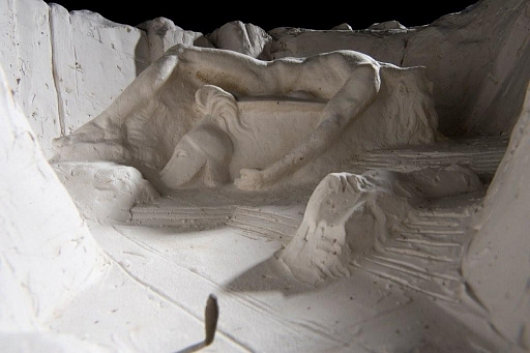
About Andrew Cusack
 Writer, web designer, etc.; born in New York; educated in Argentina, Scotland, and South Africa; now based in London.
Writer, web designer, etc.; born in New York; educated in Argentina, Scotland, and South Africa; now based in London. read more
News
Blogs
Reviews & Periodicals
Arts & Design
World
France
Mitteleuropa
Knickerbockers
Argentina
The Levant
Africa
Cape of Good Hope
Netherlands
Scandinavia
Québec
India
Muscovy
Germany
Academica
Stoddart’s Ode to Ossian
The Queen’s Sculptor Plans Great Literary Monument in the West of Scotland

Word reaches me that Alexander Stoddart, the Queen’s Sculptor in Ordinary for Scotland, has dreamed up a massive monument to Ossian. “For fifteen years Stoddart has planned ‘a national Ossianic monument’ on the west coast of Scotland,” writes Ian Jack in The Guardian. “The scale is immense. Stoddart wants a great amphitheatre cut into the rock with Ossian’s dead son, Oscar, also cut from rock, prone on his shield on the amphitheatre’s floor.” The project would be the biggest literary monument in the world, surpassing the Scott Monument on Princes Street in Edinburgh. It could be the project of a lifetime for Stoddart.
“He says a lot of people are keen, including Scottish government ministers, landowners and historians, and that a site has been identified in Morvern and a preliminary survey completed by the engineers Ove Arup. There is also environmental opposition: the kind of people, according to Stoddart, who will ‘always find two mating ptarmigan no matter where we choose’ and haven’t taken into account Schopenhauer’s view that ‘the sound of nature is the sound of perpetual screaming’. It may account for the two death threats he says he has received.”
“The Ossian poems, especially ‘Fingal’, took Europe by storm,” the journalist continues, “and gave it a new notion of the savage and sublime. A cave on Staffa became ‘Fingal’s Cave’. Goethe incorporated Ossian into The Sorrows of Young Werther and Schubert used passages of Goethe’s translation in his lieder. By Stoddart’s estimate, nothing, not even the work of Burns, has made a larger Scottish contribution to European culture. Ossian established the Scottish wilderness as a destination for Europe’s earliest tourists. Also, by ennobling Celtic antiquity, it changed Scotland’s sense of itself.”
The traditional style of Alexander Stoddart, an avowed neo-classicist, has provoked foaming at the mouth in the rather dull arts establishment, but his works — such as the David Hume statue on the Royal Mile and the frieze on the Sackler Library at Oxford — have proven popular. Scotland’s greatest living sculptor has completed a bust of Scotland’s greatest living composer, James Macmillan, as well as of Britain’s greatest living philosopher Roger Scruton. (The old-school lefty Tony Benn — another living national institution — is the subject of a Stoddard bust as well).
“The paradox is that, by revering and understanding abandoned traditions, [Stoddart] has emerged as one of the most original artists in Britain: a stranger to his times.”
Search
Instagram: @andcusack
Click here for my Instagram photos.Most Recent Posts
- Gellner’s Prague December 19, 2024
- Monsieur Bayrou December 18, 2024
- Dempsey Heiner, Art Critic December 17, 2024
- Vote AR December 16, 2024
- Articles of Note: 12 December 2024 December 12, 2024
Most Recent Comments
Book Wishlist
Monthly Archives
Categories



Interesting–an implicit reassessment of the relative significance of the fraud the Ossian phenomenon involved.
I urge your readers to use the internet to find examples of Mr Stoddart’s work.
It is superb.
As for Ossian: Stoddart’s excellent point is that the phenomenon put Scotland on the map, and its historic accuracy is irrelevant to that.
Stoddart did a magnificent bust of Pope John Paul II which is at the Pope John Paul II Cultural Center in Washington, DC. There is also a local architectural firm, Franck & Lohsen, who has made broad use of his work.
Stoddart is a genius, a real light shining the darkness of modern art. I understand he has suffered a great deal for the principled position he has taken.
Cue my favourite Dr Johnson quip, I think. When asked if he really believed that any man living could have composed (Macpherson’s, as it turns out) Ossian, the Great Bear replied: “Yes, sir. Many men, many women, and many children.”
Stoddart is marvellous, of course, and has quite transformed whole sections of Athens Borealis.
It’d be a crime if Ossian recieved further acclaim. The Ossian poems were the most pandering (to the then UK elite) nonsense of the time, with the exception of Scott himself. The tragic thing is Ossian’s author likely saw the near death of Gaelic culture through the ’45, yet still went ahead and reduced it’s real, day to day meaning to the land of faerie and guff. Get your Sorley Maclean out. That’s some proper reading.
A good account of a more ‘pure’ Scottish literary tradition can be found in ‘On the Other Side of Sorrow’ by James Hunter. I recommend it.